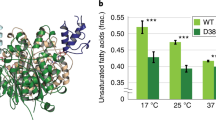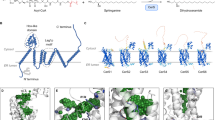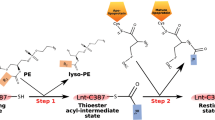Abstract
The acyl-coenzyme A-binding proteins (ACBPs) contain 26 highly conserved sequence positions. The majority of these have been mutated in the bovine protein, and their influence on the rate of two-state folding and unfolding has been measured. The results identify eight sequence positions, out of 24 probed, that are critical for fast productive folding. The residues are all hydrophobic and located in the interface between the N- and C-terminal helices. The results suggest that one specific site dominated by conserved hydrophobic residues forms the structure of the productive rate-determining folding step and that a sequential framework model can describe the protein folding reaction.
This is a preview of subscription content, access via your institution
Access options
Subscribe to this journal
Receive 12 print issues and online access
$189.00 per year
only $15.75 per issue
Buy this article
- Purchase on Springer Link
- Instant access to full article PDF
Prices may be subject to local taxes which are calculated during checkout





Similar content being viewed by others
References
Sosnick, T.R., Mayne, L., Hiller, R. & Englander, W.S. The barriers in protein folding. Nature Struct. Biol. 1, 149–156 (1994).
Jackson, S.E. & Fersht, A.R. Folding of chymotrypsin inhibitor 2. 1. Evidence for a two-state transition. Biochemistry 30, 10428–10435 (1991).
Alexander, P., Oran, J. & Bryan, P. Kinetic analysis of folding and unfolding the 56 amino acid IgG-binding domain of streptococcal protein G. Biochemistry 31, 7243–7248 (1992).
Briggs, M.S. & Roder, H. Early hydrogen-bonding events in the folding reaction of ubiquitin. Proc. Natl. Acad. Sci. USA 89, 2017–2021 (1992).
Viguera, A.R., Martinez, J.C., Filimonoc, V.V., Mateo, P.L. & Serrano, L. Thermodynamic and kinetic analysis of the SH3 domain of spectrin shows a two-state folding transition. Biochemistry 33, 2142–2150 (1994).
Huang, G.S. & Oas, T.G. Structure and stability of monomeric λ repressor: NMR evidence for two-state folding. Biochemistry 34, 3884–3892 (1995).
Kragelund, B.B., Robinson, C.V., Knudsen, J., Dobson, C.M. & Poulsen, F.M. Folding of a four-helix bundle. Studies of acyl-coenzyme A binding protein. Biochemistry 34, 7217–7224 (1995).
Schindler, T., Harrler, M., Marahiel, M.A. & Schmid, F.X. Extremely rapid folding in the absence of intermediates. Nature Struct. Biol. 2, 663–673 (1995).
Villegas, V. et al. Evidence for a two-state transition in the folding process of the activation domain of human procarboxypeptidase A2. Biochemistry 34, 15105–15110 (1995).
Scalley, M.L. et al. Kinetics of folding and unfolding the IgG binding domain of Peptostreptococcal protein L. Biochemistry 36, 3373–3382 (1997).
Schönbrunner, N., Koller, K-P. & Kiefhaber, T. Folding of the disulfide-bonded β-sheet protein tendamistat: Rapid two-state folding without hydrophobic collapse. J. Mol. Biol. 268, 526–538 (1997).
Plaxco, K.W., Spitzfaden, C., Campell, I.D. & Dobson, C.M. A comparison of the folding kinetics and thermodynamics of two homologous fibronectin type III modules. J. Mol. Biol. 270, 763–770 (1997).
Clarke, C., Hamill, S.J. & Johnson, C.M. Folding and stability of a fibronectin type III domain of human Tanascin. J. Mol. Biol. 270, 771–778 (1997).
Milla, M.E., Brown, B.M., Waldburger, C.D. & Sauer, R.T. P22 Arc repressor: transition state properties inferred from mutational effects on the rates of protein unfolding and refolding. Biochemistry 34, 13914–13919 (1997).
Fersht, A.R., Matouschek, A. & Serrano, L. The folding of an enzyme I. Theory of protein engineering analysis of stability and pathways of protein folding. J. Mol. Biol. 224, 771–782 ( 1992).
Jackson, S.E., elMasry, N. & Fersht, A.R. Structure of the hydrophobic core in the transition state for folding of chymotrypsin inhibitor 2. A critical test of the protein engineering method of analysis. Biochemistry 30, 11270–11278 (1993).
Jones, C.M. et al. Fast events in protein folding initiated by nanosecond laser photolysis. Proc. Natl. Acad. Sci. USA 90, 11860–11864 (1993).
Bryngelsen, J.D., Onuchic, J.N., Socci, N.D. & Wolynes, P.G. Funnels, pathways, and the energy landscape of protein folding: a synthesis. Proteins Struct. Funct. Genet. 21, 167– 195 (1995).
Onuchic, J.N., Wolynes, P.G., Luthey-Schulten, Z. & Socci, N.D. Toward an outline of the topography of a realistic protein-folding funnel. Proc. Natl. Acad. Sci. USA 92, 3626– 3630 (1995).
Onuchi, J.N., Socci, N.D., Luthey-Schulten, Z. & Wolynes, P.G. Protein folding funnels: the nature of the transition state ensemble. Folding & Design 1, 441–450 (1996).
Itzhaki, L.S., Otzen, D.A. & Fersht, A.R. The structure of the transition state for folding of chymotrypsin inhibitor 2 analyzed by protein engineering methods: evidence for a nucleation-condensation mechanism for protein folding. J. Mol. Biol. 254, 260–288 (1995).
Burton, R.E., Huang, G.S., Daugherty, M.A., Calderone, T.L. & Oas, T.G. The energy landscape of a fast-folding protein mapped by Ala-Gly substitutions. Nature Struct. Biol. 4, 305–310 (1997).
Lopéz-Hernandez, E., Cronet, P., Serrano, L. & Munoz, V. Folding kinetics of CheY mutants with enhanced native alpha-helix propensities. J. Mol. Biol. 266, 610–620 (1997).
Otzen, D.E., Itzhaki, L.S., elMasry, N.F., Jackson, S.E. & Fersht, A.R. Structure of the transition state for the folding/unfolding of the barley chymotrypsin inhibitor 2 and its implications for mechanisms of protein folding. Proc. Natl. Acad. Sci. USA 91, 10422–10425 (1994).
Andersen, K.V. & Poulsen, F.M. The three-dimensional structure of acyl-coenzyme A binding protein from bovine liver: structural refinement using heteronuclear multidimensional NMR spectroscopy. J. Biomol. NMR 3, 271–284 (1993).
Kragelund, B.B. et al. Fast and one-step folding of closely and distantly related homologous proteins of a four-helix bundle family. J. Mol. Biol. 256, 187–200 (1996).
Kragelund, B.B., Andersen, K.V., Madsen, J.C., Knudsen, J. & Poulsen, F.M. Three-dimensional structure of the complex between acyl-coenzyme A binding proteins and palmitoyl-coenzyme A. J. Mol. Biol. 230, 1260– 1277 (1993).
Shakhnovich, E., Abkevich, A. & Ptitsyn, O. Conserved residues and the mechanism of protein folding. Nature 379, 96–98 (1996).
Ladurner, A.G., Itzhaki, L.S. & Fersht, A.R. Strain in the folding nucleus of chymotrypsin inhibitor 2. Folding & Design 2, 363– 368 (1997).
ÓNeil, K.T. & Degrado, W.F. A thermodynamic scale for the helix-forming tendencies of the commonly occurring amino acids. Science 250, 646–651 (1990).
Kragelund, B.B. et al. Conserved residues and their role in the structure, function, and stability of acyl-coenzyme A binding protein. Biochemistry 38, 2386–2394 (1999).32. Tanford, C. Protein denaturation, part C. Theoretical models for the mechanism of denaturation. Adv. Prot. Chem. 24, 1– 95 (1970).
Tanford, C. Protein denaturation, part C. Theoretical models for the mechanism of denaturation. Adv. Prot. Chem. 24, 1– 95 (1970).
Myers, J. K, Pace, C.N. & Scholtz, J.M. Denaturant m values and heat capacity changes: Relation to changes in accessible surface areas of protein unfolding. Protein Sci. 4, 2138–2148 (1995).
Shortle, D. Staphylococcal nuclease: a showcase of m-value effects. Adv. Protein Chem. 46, 217–247 (1995).
Thompson, P.A., Eaton, W.A. & Hofrichter, J. Laser temperature jump study of the helix-coil kinetics of an alanine peptide interpreted with a kinetic zipper model. Biochemistry 36, 9200–9210 (1997).
Anfinsen, C. The formation and stabilization of protein structure. Biochem. J. 128, 737–749 (1972).
Ptitsyn, O. Protein folding: hypotheses and experiments. J. Protein Chem. 6, 273–293 (1987).
Karplus, M. & Weaver, D.L. Protein-folding dynamics. Nature 260, 404–406 (1976).
Karplus, M. & Weaver, D.L. Protein folding dynamics: the diffusion-collision model and experimental data. Protein Sci. 3, 650–668 (1994).
Grantcharova, V.P., Riddle, D.S., Santiago, J.V., & Baker, D. Important role of hydrogen bonds in the structurally polarized transition state for folding of the src SH3 domain. Nature Struct. Biol. 5, 714–720 (1998).
Martinez, J.C., Pisabarro, M.T., & Serrano, L. Obligatory steps in protein folding and the conformational diversity of the transition state. Nature Struct. Biol. 5, 721–729 (1998).
Burton, R.E., Myers, J.K. & Oas, T.G. Protein folding dynamics: quantitative comparison between theory and experiment. Biochemistry 37, 5337–5343 (1998).
Duan, Y. & Kollman, P.A. Pathways to a protein folding intermediate observed in a 1-microsecond simulation in aqueous solution. Science 282, 740–744 (1998).
Mandrup, S. et al. Gene synthesis, expression in Escherichia coli, purification and characterization of the recombinant bovine acyl-coenzyme A binding protein. Biochem. J. 276, 817–823 (1991).
Rosendal, J., Ertbjerg, P. & Knudsen, J. Characterization of ligand binding to acyl-CoA binding protein. Biochem. J. 290, 321– 326 (1993).
Kjær, M., Andersen, K.V. & Poulsen, F.M. Automated and semiautomated analysis of homo- and heteronuclear multidimensional nuclear magnetic resonance spectra of proteins: the program PRONTO. Methods Enzymol. 239, 288–307 (1994).
Hubbard, S.J & Thornton, J.M. 'NACCESS', computer program. (Department of Biochemistry and Molecular Biology, University College, London; 1993).
Acknowledgements
K. Hansen, J. Stenvang Jepsen, K. Poulsen, S. Radmehr and P.V. Sørensen are acknowledged for production of some ACBP variants. E. Knudsen, J. Andersen and P. Skovgaard are acknowledged for skilled technical assistance, and C. Rischel is thanked for providing the program CANOO. We acknowledge the advice to make additional mutations from the referees of this paper. This publication is a contribution from the Danish Protein Engineering Research Center and is also supported by the Danish Natural Research Councils.
Author information
Authors and Affiliations
Corresponding author
Rights and permissions
About this article
Cite this article
Kragelund, B., Osmark, P., Neergaard, T. et al. The formation of a native-like structure containing eight conserved hydrophobic residues is rate limiting in two-state protein folding of ACBP. Nat Struct Mol Biol 6, 594–601 (1999). https://doi.org/10.1038/9384
Received:
Accepted:
Issue Date:
DOI: https://doi.org/10.1038/9384
This article is cited by
-
Local Structural Stability of the Acyl-Coenzyme A Binding Protein by ESR Spectroscopy
Applied Magnetic Resonance (2023)
-
Model-independent interpretation of NMR relaxation data for unfolded proteins: the acid-denatured state of ACBP
Journal of Biomolecular NMR (2008)



